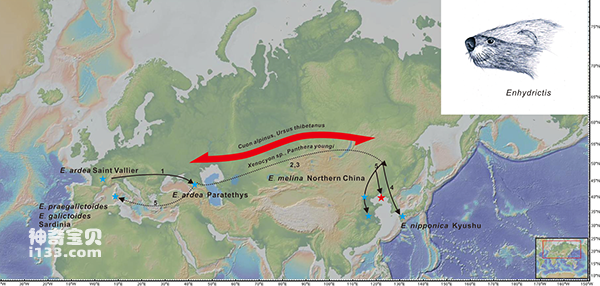The steppe weasel Lyncodontini is a small mustelid that is now only distributed in South America. However, during the Quaternary period, the steppe weasel once spread across Eurasia, especially the European sea otter martens Enhydrictis and Pannonictis. Relatively few grassland weasel animals have been discovered in East Asia. In the past, only the weasel Eirictis was reported, which lived in the early Pleistocene. Currently, there are fossils of this kind of animal in Longdan, Gansu, Renzi Cave in Fanchang, Anhui, and Tuozi Cave in Nanjing, Jiangsu. Discover. When Mr. Pei Wenzhong reported on the carnivore fossils at the Zhoukoudian "Ape Man Site" in 1934, a type of medium-sized mustelids similar to otters but different were commonly found. At that time, he named them badger-type otters, but mentioned that this type of The animal may not be a true otter. Later, when Ogino Shintaro revised the Japanese otter in Kyushu Island, Japan, he believed that the Japanese otter and the badger-type otter in Zhoukoudian were both members of the grassland weasel tribe, and established a new genus Oriental weasel Oriensictis. Unfortunately, the materials from Zhoukoudian are too fragmented and contain only scattered teeth, so scholars still have some controversy over the true ownership of this type of animal.
In recent years, the Dalian Field Research Team of the Institute of Vertebrate Paleontology, Chinese Academy of Sciences, led by researcher Jin Changzhu and associate researcher Wang Yuan, has cooperated with Dalian Puwan Economic Zone, Dalian Nature Museum and other units to persist in Jinyuan Cave in Luotuo Mountain, Dalian Puwan. After more than five years of field excavation, a large number of Pleistocene mammal fossils of diverse genera and species were collected. Recently, Jiang Zuo Qigao, a doctoral candidate from the Institute of Paleovertebra, and his supervisor, researcher Liu Jinyi, collaborated with colleagues from the Dalian Museum of Natural History and the Dalian Puwan Economic Zone to report on a piece of bone accumulated in the upper part of Jinyuan Cave in Luotuo Mountain, Puwan, Dalian. Complete medium-sized mustelid skull. The dental characteristics of this skull fossil are highly consistent with those of the badger-shaped otter from Zhoukoudian and belong to the same species. However, its skull characteristics are very close to those of the sea otter marten endemic to Sardinia in the Middle and Late Pleistocene of Europe. After detailed comparative studies and phylogenetic analysis, the researchers found that the mustelids from Jinyuandong, Zhoukoudian and Japan can all be classified into the genus Sea Otter, but belong to different species, namely the badger-type sea otter (Jinyuandong, Zhoukoudian). ) and Japanese sea otter marten (Japan). The badger-shaped sea otter is the largest and strongest member of the genus Sea Otter (estimated to weigh 5-10kg). It has thick canines and molars (durophagous characteristics) and may have the ability to hunt larger prey. The results have been published online in Quaternary International.
The discovery of Jinyuan Cave in Puwan Luotuoshan not only confirmed that the "badger-type otter" indeed belongs to the grassland weasel tribe, enriching the fossil record of the grassland weasel tribe in East Asia, but also revealed two important facts:
1. The age of the upper layer of Jinyuan Cave may be the same period or quite close to that of the Zhoukoudian "Ape Man Site". Jinyuan Cave is a large cave accumulation discovered in the Puwan area of Dalian in recent years. The sediments exceed 30m from bottom to top. Three-toed horses and real horses were found to coexist in the lower layer. The age is the early Pleistocene, and the sea otter and marten discovered this time The age of the upper layer is limited to the Middle Pleistocene. In this way, Jinyuan Cave has become the first single-section accumulation in northern China that spans almost continuously from the Early Pleistocene to the Middle Pleistocene.
2. The common European animals that first appeared in the Middle Pleistocene in northern China, in addition to sea otter and marten, there are also Xenocyon sp. found in Zhoukoudian, and Panthera youngi (which may be very close to the European cave lion) . At this time, some unique components of East Asia also appeared in Europe for the first time: the jackal Cuon spp. and the Asiatic black bear Ursus thibetanus. This large-scale biological exchange event is likely related to climate changes during the mid-Pleistocene transition. During the Mid-Pleistocene Transition, the cycle of global climate fluctuations changed from 40,000 years to 100,000 years. This cycle shift has increased the interval between glacial and interglacial periods to a certain extent. Therefore, during the interglacial period, biological communication corridors in Eurasia existed for a longer period of time, allowing these faster-moving carnivores to migrate from one end of Eurasia to the other.
This research was funded by the National Natural Science Foundation of China, the Dalian Puwan Economic Zone Horizontal Project, the Strategic Priority Science and Technology Project of the Chinese Academy of Sciences, and the China-Czech Cooperation Project.

Figure 1. Location and cross-section of Jinyuan Cave in Luotuo Mountain, Dalian (Photo provided by Jiangzuo Qigao)

Figure 2. Badger-shaped sea otter and marten skull (Photo provided by Jiangzuo Qigao)

Figure 3. Migration path of badger-shaped sea otter and marten, restoration map and schematic diagram of biological exchange during the mid-Pleistocene transition period (Photo provided by Jiangzuo Qigao)
animal tags: badger
We created this article in conjunction with AI technology, then made sure it was fact-checked and edited by a Animals Top editor.